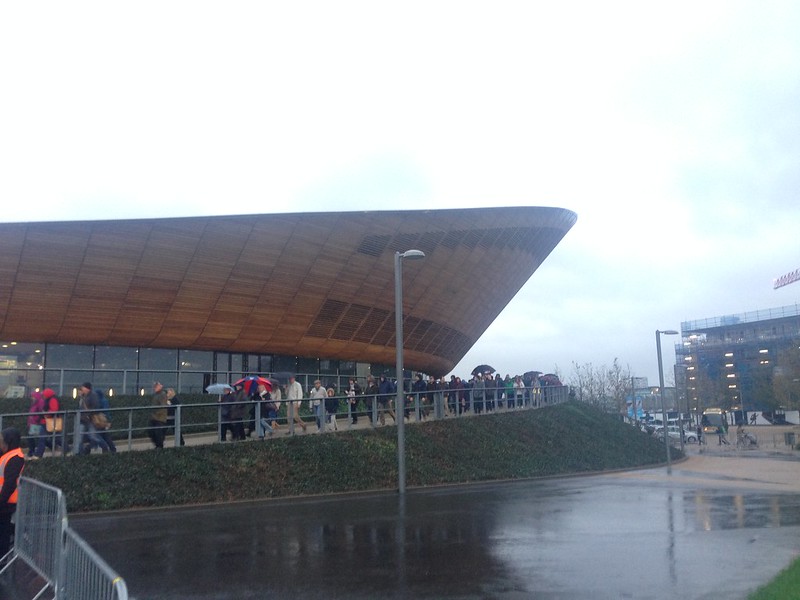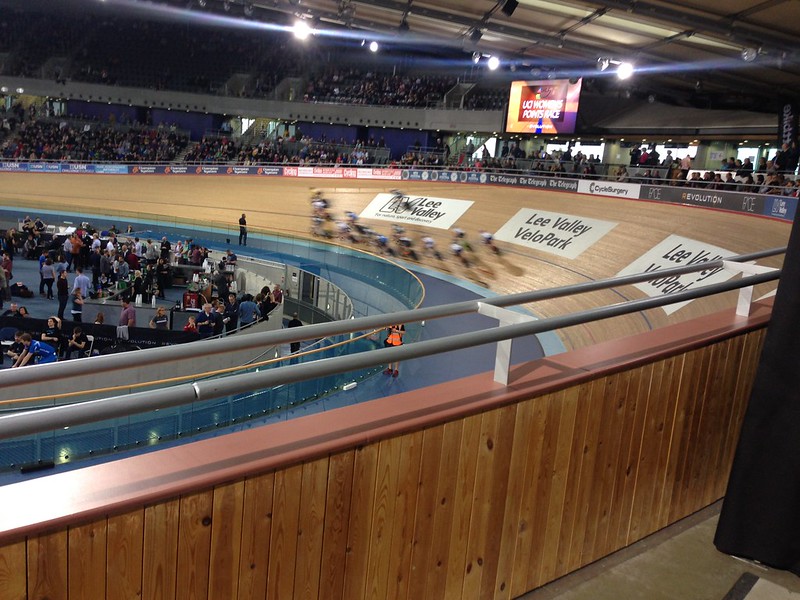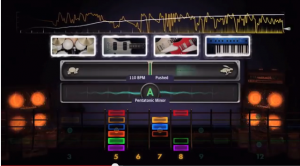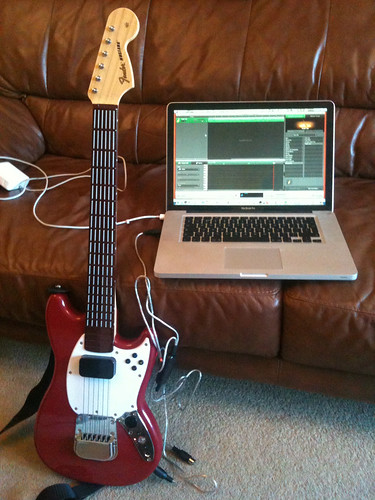On Saturday we took a family trip to London to the Lee Valley Velodrome on the 2012 Olympic park site. We had tickets to see the Revolution series. Here various pro cycling teams and riders from around the world compete indoors on the banked circuit. WE had been to see some of the Olympics during 2012 but that was the gymnastics at the O2/Millennium Dome so we had not seen the big stadium, giant sculpture nor the velodrome yet.
As predlet 1.0 is currently on crutches, with a heavily sprained ankle, we chose to go overland from Waterloo station to the park in North East London. The cabbie set off North, but our visit clashes with the road closures for the Lord Mayor’s show. So after a u-turn we skirted around the city and then he headed up towards the Velodrome. It was a drizzly rainy day but we did get to see a lot of London.
The Velodrome itself is a fantastic looking building from the outside.

It is a huge bowed wood clad curve. The entire building is raised up on a plinth and the glass walls around appear to support the wooden structure. You are let in through an air lock in small groups. The idea is to keep the air and temperature stable inside to protect the track.
Inside it makes sense that the entire structure is raised up as the banked track is incredibly deep and steep.

There are two tiers of seating, but everyone can see everything. The riders and track were very close to our seats, and we got a good view down a straight.
The preparation area, for warm up and warm down is located in the infield. So there is always something going on, some form of activity.
We got to see several types of races and mass warmups around the track in between too. The first was with individual riders. It was just them against the track and the clock. Whilst not being bike racing affiecienados it was amazing how quickly we all saw the minute differences in technique and speed that led to different times. You just knew when the winning time was being made. You could feel the wonderful interlocking of all the training with the effort on the day coming into play. The first 200m race (which the clock started a little after the start finish line) was separated by milliseconds. The top time were around 10 seconds to cover the 200m, after 2 laps to wind up to the sprint.
The predlets had not really come across fixed wheel bikes but they soon got the gist of how they worked and the fact these athletes were traveling at over 40 miles and hour with no brakes.
The sprint races were great, it was very crowd friendly and we were able to cheer and support everyone, but particularly the locals. Everyone was cheered though. It is incredibly obvious the effort that they have to put in to be able to move at those speeds. The banked curves and the pressure to try and control the bike, choosing the right line etc it less obvious but was intriguing to watch.
The one on one races were interesting too. These are the ones where the try and catch one another out. They have three laps to complete, but the first one or two are done at a very slow pace, keeping an eye out for the break. The acceleration and power as they wind up the bikes means a fraction of a seconds jump on someone matters. Equally, go to early and you loose power or the other person gets a slip stream. Again these were easy to follow.
The most impressive races were the mass races of 20 or so riders. The Women’s race was 80 laps and the Men’s 120. They tended to stay in a streamlined group unless one chose to break away. Every 10 laps was a sprint lap with points awarded for the top people crossing first. Extra points were on offer for lapping the field. Here is got a bit confusing, the comentator did their best but we got a bit lost as to the rules. When and where the lapping occurred and if it got reset after the sprint lap. It was very impressive though. a constant almost silent whoosh of power sooting past every 10-12 seconds.


Another race format was the elimination. Each lap the one at the back dropped off until there were 10 then they raced.
The final race was the strangest. A large proportion of it involved not racing at all. It was called the Longest Lap. Here all the riders attempted to balance near the star finish line, on the banked straight. They had to stay upright, no crossing the line for 3-4 minutes. A foot down or holding on and they were out. Then the signal would go and they all raced form a standing start for 1 lap. About 1/3 dropped out before the race.
It was interesting, but seemed a little odd. Then I remembered we used to do this as kids. How long can you balance on your bike without moving. So it is not quite so odd. As a spectator sport watching people balance was actually good too.
We had a great time at the Velodrome. I have to say the tea at the canteen was great too. Lots of venues have food places that are pretty bad or just non-descript. The fresh crepes, cakes and tea at Lee Valley are very nice though.
I entitled this post human endeavour – it is what counts. The combined experience of the science and technology and engineering that created the building, with the effort that the athletes and their teams put in and the variety of experiences over and above just cycling fast combined with a willing and happy crowd of spectators was and is very uplifting.
Everything is about building and improving. That includes hard work and effort, that making it worthy of celebration.
The previous weekend we had our annual trip to see Jools Holland and his Rhythm and Blue Orchestra. It was another amazing show, as usual. In fact it was probably one of the best yet. It is another example where the hard work and effort of the musicians to learn their craft is celebrated by them sharing it with us. The dexterity of Jools Holland on the piano is stunning, the drum solo by Golson Lavis is always a fantastic highlight. Not only one of the greatest drummers ever, but he is there all the time for the whole 2 hour show. These solos everyone else leaves and lets him get in with it. Here is an example. It is well worth the listing to the whole thing and feeling the effort and the effortlessness combine with all his years of experience.
Everyone should have the opportunity to find their talent and to work at to, building on all that came before. It is human endeavour that counts.
music
Theme tune
A while back I invested in the Unwinnable Kickstarter campaign to create a weekly quirky look at video games. I picked as one of my rewards a personal them tune composed by George Collazo I was intrigued at what might come out of such an exercise. Those of us getting a tune done filled in an interesting set of questions. I got a tweet just now for George saying my tune was ready. I click play and loved it, then read what George had used as inspiration.
” I tried to combine super spy James bond style coolness with pure Bruce Lee badassey with Enter the Epredator.” Yes tech and martial arts in an awesome tune!
Thankyou George! I love it.
2.3.4 dum diddle um dee dum dum, dum diddle um de darm.
Rocksmith 2014 – Now that is clever learning software!
A few days ago my a new version of my favourite console application arrived Rocksmith 2014. I had seen the press release video of some of the new things in Rocksmith and they did look interesting. For once my expectations have been exceeded though. Rocksmith 2014 session mode is probably the best piece of software I have ever seen or used. That is a pretty big claim to make but it makes playing the guitar just feel right.
They have improved a lot of other things about the regular tune learning too. Just in case you are not aware this is a guitar “game” that you plug a real electric guitar into you console/PC and the device acts both as an amp but also as a guide. It knows the notes you are playing.
So to learn a tune the notes stream at you indicating the fret and the string (colour coded as well as positional). If you hit the note, great, it will start adding more notes and chords in to level you up. Miss and it will start to make life simpler. This is with real music, the original versions in every style under the sun.
The new version provides challenges in each song and coaches you through, there is less focus on the score, though score attack mode still exists. It is about the playing and about it feeling and sounding right.
The previous version had a way to isolate a section or a riff and repeat it, first slowly then speeding up. The new version has this but with lots more options about the number of repeats, the initial speed the level jumps etc, all easy to adjust. It also lets you just hit a button whilst playing the whole song and jump to riff repeating where you are in that song. Something that was awkward to navigate to before.
All the old DLC from the previous version is ported to the new version, though…. they rather cynically charge you another £7 or so to do so. If you have bought a lot of tunes then I would have expected some loyalty bonus. The additional tunes are now also £1.99 which seems steep, but then they are not just the music but the structure of the song and how to learn it. If you think how much guitar lessons might cost it is minimal really.
The real extra star of the show though is session mode. However it has been built it provides, to me at least, a fantastic backing band for any guitar noodling I feel like doing.
I love playing the blues scale, in the past I have tried playing along with famous tunes on CD’s and tapes, obviously that never gets to the standard of the stars of the blues world that are playing those tunes. I have also had backing tracks with books etc they are fine if you are trying a fixed thing to play. Session mode lets you load a band, lots of styles and types. Blues has 5 or 6 specific types on its own let alone Rock, Metal, Indie etc. In the set up you can pick a key, a scale and things around tempo and the relaxed or rigid nature of your backing band.

Then you start to play. Initially the band are doing nothing, but the first few notes on the scale you have chosen (which is highlighted on the fretboard on screen) starts to set the band in motion. The drummer and bass kick in at the sort of pace and intensity you start. Even just playing the scale slowly gets them going. Before long you find a little riff to play and maybe some chords and before you know it the other instruments keyboards, and guitars are joining in filling you room, in this case, with the blues. If you have set it to a more formal structure the band will start making the changes as in a 12 bar blues and the the onscreen scale suggests the notes that work in those step changes. Of course you can play what you want. Speed up slow down the band goes with you and it doesn’t just feel like a load of loops being triggered. There seems to be a more complex analysis of the notes you play that gets the band doing their thing. You can almost nod to them when you want to step it up or hit a quite solo. It is stunning.
I am not a musician by any sense of the imagination, but I have tried guitar many times. The previous Rocksmith taught me a lot, something that it continues to do in learning songs. However session mode is the delight. It is a very clever, very patient, non judgemental band. Experimenting with riffs and scales in lots of styles is truly enlightening and relaxing. It is not about trying to hit a note, keep up, make a score, copy a sound but instead find a self expression through making music.
It is not without it’s downside but one does have to suffer for one’s art darling

My fingers have now hardened a bit again, you just have to soak blisters in lemon juice and keep playing on them.
There was something else very cool about 2014. It is even better for 2 guitars now. Predlet 2.0 plugged his little electric guitar in and we jammed in session mode. He explored what happened as hit hit notes fast and slow and we even did a bit of riff turn taking. A right noise for everyone else in the house but we had fun. We then moved on an made more racket playing Billy Idol White Wedding which is a bit go a fave tune of ours 🙂
I am not on their payroll, just a very enthusiastic fan. If you like guitar you have to get this !
Generating music from an emotion curve
I just came across this interesting looking web application called MusicFlow. I am always fascinated by things that make the creative process more open to anyone. Clearly fully fledged composer and musician is better than a generated algorithm but…. Here you draw a graph on a time line of the sort of rise and fall of emotion you need and it creates a piece of music for that.
There are several video demos, but before I watched these I just had a quick go and straight away had an interesting piece going.
We have some similar things now in iMovie where it generates a score based on the pace of the film, the cuts etc, but it is good to see a more generic one hit the web.
I was also reminded of the old Instant Music program on the Amiga again, as that was the first one I saw that was able to allow an in tune jamming using the mouse which is similar in many ways to drawing an emotion curve. Anyone else remember that?
Thinking out of the music box – Physical/Digital blur
A rather brilliant use of Quadrocopters has been doing the rounds this week with this James Bond theme. It is a very physical creation of music, powered by robotics but with the jeopardy of free flying and the physics of the real physical world thrown in.
It is mesmerising and obviously very geeky!
This expansion of the old fashioned music box principle, with mechanical parts playing notes based on their physical spacing in a roll of punched paper, or as pins in a metal drum out is always being expanded. Many people are thinking out of the very literal music box.
Along these lines is the wonderful car driving video from OK Go, exponents of the unusual video.
Notice this even starts as a music box principle on the front of the car before becoming stunningly huge in its layout and concept.
Many of the games that have any sort of sound capability and user created content or modding often end up with layout builds of music machines too, as we see in Minecraft
This gets taken to an even further extreme with games like FRACT osc which is shaping up to be a stunning game set in a musical synthesiser world.
This is looking really interesting. This level of creative interaction is all part of the waves of Maker Culture in an unusual form.
Music, Lights and exceptional pies
This weeks Cool Stuff Collective was fully of twists and turns. Whilst we don’t have a lot of scripted gags we do have a few things that are repeated throughout the series. As we are technically half way through the guys at Archie Productions now throw in alterations to what has become an established pattern. Hence making it more funny. (That’s enough analysis of comedy writing).
In Future Tech I had the interesting musical light show the Tenori-On to talk to Vicky about. Using a live instrument with 64 buttons, and 16 modes of operating was a bit of a continuity knightmare but I tried to learn it enough that I could repeat various things as needed.

I had a few days to experiment with it and become one with it, but as i am a tech geek not a musician ….
It is a bit like the monome used to be, an intriguing shape and feel to it. In many ways its like playing with Midi equipped bubble wrap. I found it fascinating though. It generates all its own tunes and is a multi layer sequencer. Some of the drawing modes that let you swipe across and twirl around yet create some soothing electronic music feels very theraputic.
We discussed in the piece how new ways to generate and record music were being powered by tech, but that it is not a replacement for traditional instruments. Remembering back to the original days of the synth when some were heralding the end of all instruments. There is a lot to be said for the performance element of a traditional instrument, the skill needed to interact and the subtley. Still tech instruments are cool too 🙂
I also got to mention, though not show (as it was still in customs!) the Ninjen Gaki a quirky little device that uses human body electrical resistance to modify the sounds it makes. You hold onto it and grab someone else’s arm who is holding the device too and it plays notes.

However it was at the end of the piece that the twists started. Traditionally Vicky asks me a question and I stomp off in a huff saying I am not a whatever the gag is, I am a tech geek. In this one I get to turn the tables and ask Vicky a question. She strops off and I get to do the “oooooh touchy” to camera. All in good fun.
However it was in the Wall of Fame that the biggest twist hit. Not only did I get to pie the unfortunate holder of the toy that got the “pants” vote but Blowfish was in the line of fire.
Now before you look at these pictures you should know that Blowfish is actually a serious marine biologist not just a pie target, but then I am a “serious” tech geek too 🙂 You can see some of his passion to ecology and the see here at School Of Fish
When you have done that check out this Saturday morning kids TV classic moment 🙂


Thankyou for being such a good sport, and yes I know what goes around comes around!
You can (in the UK) see this all, and the back catalogue on the ITV player.
Pixelated Truth – Art, music and performance in Second Life
It’s not all powerpoints and offices in the metaverse you know.
Claus Uriza from the wonderful PopArtLab was the driving force behind the creation of this excellant Machinima music video for Giana Factory’s new song Pixelated Truth. FuzonAcid directed the video and I think it shows that we often forget the depth of creativity that makes Second Life such an interesting medium. 20 actors performed in real time with their avatars being filmed for this. You can think of it as a form of very rich puppetry. Which when combined with great editing and and storytelling set to music is a very powerful package.
Enjoy, and think of the possibilities. You can create create things like this in a virtual world.
Lets rock! – MIDI game guitars FTW
I have to admit not really a musician, but I do like guitars. I know a little of the lead blues scale and a few chords. I also love playing Rockband. I have dabbled with plugging my old electric guitar into the usb port of the Mac but the socket in the guitar has a bit of a loose connection so its always a crackly affair.
Getting the MadKatz Rockband 3 guitar for christmas and seeing the midi connector on it I thought it was time to try and plug that into the Mac. I ordered a MIDI to USB which just arrived and … well it just worked.

It got easier to play it than in Rockband 3 as you obviously play what you want, so it was much quicker to get comfortable with it. Rockband 3 could do with a free jam mode like it has with the drums for this purpose.
Garageband does things nice and simply but it is very easy to record and playback then change instruments or add tracks.
What was interesting was that the effects combined with my playing errors come together to sound not too bad. In this video I just played a sequence of C F and G chords and picked a few instruments to render that with.
I also discovered (as I am not sure its documented but if it is I have lost the instructions) that the start button on the Xbox guitar switches the guitar to a no strum mode. Simply pressing and golding the fret buttons creates the note and sustain. The X and B buttons step the instrument up or down octaves. I am not sure if the others do anything. As there is no Whammy bar you cant do any odd effects. Also the thing missing from buttons is string bend which is a pity but otherwise this all feels great fun and you can make proper music.
I also plugged the keyboard in, they slider effect worked nicely on that, but as I know even less keyboard I went back to the guitar.
I have been sitting noodling around the scales making up little tunes, playing blues lead on top of a few tracks etc. Every time I go back to metal strings on the real guitar, as I don’t play enough, the blisters are pretty bad. These buttons are not having any such side effect.
It’s great fun.
When I tweeted about this I got sent this link to an even flashier midi guitar by @mummabear, check this one out, the Misa digital kitara
Reaching into music with Melodyne
A few years ago I remember we saw a demo of an upcoming product that let you dive directly into the individual notes of an already produced piece of music. i.e. you went from the produced target not the original source. Roo posted it at the time
It was great to bump into the website for the Melodyne editor at Celemony whilst doing some other research.
The really cool thing is they have a full demo for Mac and Windows that lets you play with 9 seconds of any tune you care to throw at it.
I used one of the loops from Garage Band, but only a little bit on this video just to show how simple it is to edit.
The first play is the original but then I move one note up. Note that in this particular view there are other notes playing too as it is part of a chord. So from a Wav file even I can change the individual notes of a track !
So this is me simply importing a wav (in seconds), and dragging a note. Done!
They have lots of flavours of the application but the Editor demoed here is only actually £300 ! The demo download link is on the product web page
Even with the 9 seconds to play with you can feel the amazing power of this. Now if I could just find my own musical talent…
More geek parody songs – Nerdcore evolving
One of the greatest things about the web is that whilst there may be the ability for anyone to share anything that is truly rubbish, there is also the ability to share things that for a niche audience they will appreciate and love. One such thing is this very clever, but very geek related parody of the Katy Perry/Snoop California song.
You will see if you click through ti YouTube Skyway Flyer has put the transcript of the lyrics too, in case anyone who is not so geeky has to look up Flux Capacitor.
I bumped into this one though on Buzzfeed. Yes another service to help us thread and aggregate interesting things.
It was here Buzzfeed (thanks to Rita King and Jerry Paffendorf for pointing me at it) lets you rate and badge content from elsewhere and then spread the word.
I have been dabbling with a few things on there as epredator
It is sort of categorized into LOL and GEEKY etc. For these geek parodies though I suspect they will fill up the feed very quickly 🙂 If they are as good as this one and the previous New Dork one then I am happy.
Nerdcore as a music form seems to be ever on the increase, creative people who are also tech geeks taking a tongue in cheek look at life and sharing it over the very medium they are spoofing.
Maybe I need to give it a go to. I have a smattering of musicality (though only a smattering), lots of kit and a world audience to find a few people who might like it. If nothing else the ballad of the metaverse may be a better way to share a story than an old school book. Though…. that may have to be a geek opera rather than a youtube short 🙂
